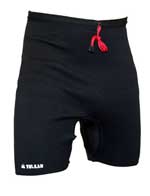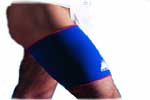Thigh Muscle Pain Strain Injury & Football
March 28 2008 | Articles
Thigh Muscle Strain Injury Explained
In sports like football where kicking is a regular activity, Thigh muscle strain is a common occurrence. This injury is a result of a tear in the Quadriceps muscle group. It is found at the front of the thigh. The Quadriceps muscle group is responsible for movements that involve extending the knee. The Quadriceps group is composed of four muscles: Rectus Femoris, Vastus Lateralis, Vastus Intermedius and Vastus Medialis.
In activities such as sprinting or kicking, an excessive force is applied to the muscles such as them being stretched beyond their limits. These activities eventually result to a tear in the muscle tissues. When such a tear occurs in one of the thigh muscles, it is referred to as Thigh strain. Depending on its severity, the thigh tear may range from a first to a third degree strain.
• In a first degree strain, only a few muscle fibres are damaged.
• In a second degree strain, the damage would involve a more extensive number of muscle fibres.
• In a third degree strain, the muscle itself would have a complete rupture.
Thigh Muscle Strain Signs & Symptoms
A grade one thigh strain may be felt only after the activity is over. The patient may feel sensations similar to a cramp. He or she may also experience tightness in the thigh along with some pain when extending or contracting the thigh muscles.
A grade two strain’s effects will be felt immediately. There will be a more severe pain and the injury will also make walking extremely painful. The injury will be verified if there is throbbing when the muscle is either stretched or contracted. Also, this degree of strain will be sore to touch.
The most severe of all, a grade three injury would involve a complete tear in the muscle itself. In this grade, the patient will instantly experience stabbing pains emanating from the thigh. Walking will also come with an extreme amount of pain. Because of the tear, there may be a visible depression in the thigh as well as a lump above that depression. An injury of this magnitude will also cause internal bleeding which, after a few days, will manifest as large bruises on the skin.
Thigh Muscle Strain Treatment
In order to lessen the bleeding and the damage within the tissues, a combination of rest, ice and compression must be immediately applied to the injury. Although resting may seem like a typical form of treatment, many competitive athletes fail to recognize its importance. Failure to have adequate rest could be very dangerous since it takes very little for an injury to escalate from one degree of severity to another. In general, a patient must refrain from any sports-related activity for about three weeks in order to facilitate healing of a grade one Thigh strain.
For a grade two thigh strain, rest must be increased to about four to six weeks. In the case of a grade three strain, a surgery will be necessary in order to repair the ruptured muscles. After the procedure, the patient must undergo rehabilitation for three months.
Whether the patient has a grade one, two or three injury, the immediate treatment of the thigh strain is the same. With a compression bandage put in place, the thigh must be elevated and must be refrained from any motion. An ice pack must also be applied at two-hour intervals, for 20 minutes each time. The bleeding, as well as the inflammation of the tissues will be reduced after these procedures have been carried out. More active rehabilitation may begin only after the patient has had a couple days of rest.
During the healing process, a scar tissue will form on the area of injury. Gentle resistance exercises along with thigh stretching will aid in the alignment of the scar. The tensile strength of the thigh muscle will improve once the scar tissue is properly aligned along the normal lines of stress.
In the beginning, a therapist will provide gentle resistance. However, as the muscle heals and strengthens, it will be possible to use resistance bands that can offer a more challenging exercise. The number of sets and repetitions performed will be gradually increased. Eventually, the patient will be able to start working on his Core strength.
By enhancing muscle function across the torso and the pelvis, exercises dedicated to Core Strength and Core Stability will help reduce the risk of injuries to the Hamstring. Ideally, core strength exercise should be done with the use of a Swiss Ball (below) along with resistance bands.
Functional activity is possible after the strength of both the Core and the Hamstring are developed. Gentle jogging can be started seven to nine days after sustaining a grade one injury. Meanwhile, straight line sprinting may be initiated three weeks from the date of injury. During this active physiotherapy, the use of Warm Pants (Compression Pants) or thigh support may provide reassurance.
An ideal method to maintain fitness while on rehabilitation is running in the pool with the help of a buoyancy aid.
Thigh Muscle Strain Prevention
The following measures may help in reducing the risk of sustaining thigh injuries:
• Before participating in matches and trainings, it is ideal to warm up first. In warming up, the temperature of muscle tissues is increased by one or two degrees. This makes the muscle more flexible and thus, less susceptible to muscle stretch injuries. Ideally, the warm up should last for twenty minutes, with the exercise beginning at a gentle pace and ending with full pace activity. In order to develop coordination while improving mental preparedness, the warm up must also be utilised to practice sport-specific movements and routines. Warm pants or thigh support may be worn since they can help maintain the muscle temperature while providing protection against muscle injuries.
• A cool down after training sessions will also help enhance the patient’s recovery. The process of cooling down is believed to be helpful in cleansing the body of its waste products. Stretching exercises may also be added.
• Muscle strains may also be prevented if the person maintains good flexibility as well as excellent muscle strength. Excellent muscle strength assures the person of a high level of control when performing activities. This lessens the occurrence of uncoordinated movements that can lead to injury.
• Strains are often associated with tightness in the muscles. To maintain muscle length and prevent injury, it is advisable to stretch on a gym mat.
• A person’s diet also plays a part in the prevention of injuries. In order to have an adequate supply of energy needed to perform muscle contractions, a player’s diet must be high in carbohydrates during the 48 hours prior to a match. However, if the player is short on carbohydrates and on energy, fatigue will easily set in. This fatigue increases his risk for injury so energy bars and gels may be necessary to increase his stamina.
Football Rescue Recommends
![]()
![]()
![]()
![]()
![]() 5 Star Rating
5 Star Rating

Best Seller
Description
Ultra thin and comfortable neoprene compression shorts offering increased support to the groin, thigh and hamstring region.
How it Works
The compression and warmth provided by the Vulkan Warm Pants is perfect for the treatment and prevention of thigh, groin and hamstring muscle strains. Compression helps to provide physical support and reassurance, while the therapeutic heat helps to increase and retain muscle temperature. This helps to make soft tissues more ‘stretchy’ and less prone to strain injury.
When to use it
It can be useful during severe and persistent hamstring, groin and thigh muscle strains. The warmth provided by the neoprene support can also be very useful for the prevention of muscle strains.
View neoprene shorts that provide compression and support for thighs, groin and hamstring injuries

The Vulkan Neoprene range features premium quality neoprene. This offers the best possible combination of support, compression, heat retention and comfort. Vulkan Neoprene has a unique spiral lining which is critical in removing excess sweat which avoids skin problems and is more comfortable to wear.
By retaining heat there is an increase in the elasticity of the soft tissues. This is helpful for the treatment and prevention of a thigh muscle injury. By increasing local blood flow, healing and recovery times can be reduced following a thigh injury. The Vulkan Thigh support can also be used as a preventive measure where there has been a history of thigh muscle injury. By warming the tissues and acting as a heat retainer it can reduce the risk of re-injury.
When to use it?
The Vulkan Thigh Support can be useful during acute and chronic hamstring and thigh muscle strains. The warmth provided by the neoprene support can also be very useful for the prevention of hamstring and thigh muscle strains. It is easy to apply and doesn’t restrict movement, making it ideal for use in all sports.
View hamstring supports that provide warmth, compression and support to injured thigh & hamstring areas
